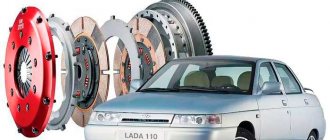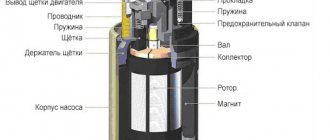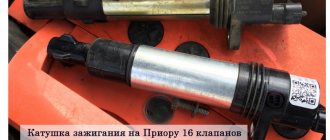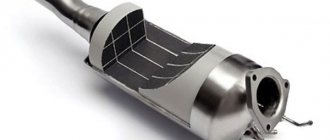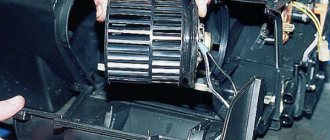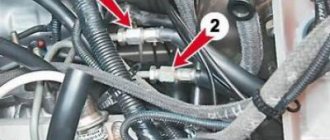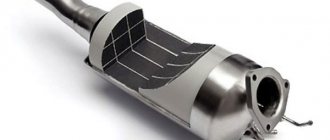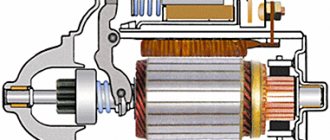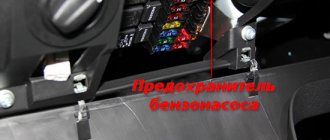Comfort in the cabin when operating the car in winter is ensured by a stove in the cabin. Before the advent of the “tenth” family of models, AvtoVAZ equipped its cars with a simple mechanically controlled heating system. Starting with the VAZ-2110 model, designers revised the design of the stove and improved its control mechanism. Such modifications increase the convenience of adjusting the heating operation, and sometimes cause failure or improper functioning of the interior heating.
The design of the heating system of the VAZ-2110
The concept of interior heating on the VAZ-2110 remains the same - the air supplied to the cabin is heated by the cooling system. To do this, a radiator is installed in the cabin, under the front panel, which is included in the cooling system; heated antifreeze moves through it. The air passing through the radiator is supplied through the air intake. After heating, the air flow through the air ducts is supplied to the necessary areas - the windshield, legs, torso.
Forced air circulation is provided, which increases the efficiency of the distribution of warm flow throughout the cabin. For this purpose, the stove is equipped with a fan driven by an electric motor.
The air heating temperature is regulated by dampers. One of them allows the flow either through the radiator (for heating) or bypassing it. The damper divides the flow to obtain the desired temperature - one part of it goes through the radiator, and the second bypasses it, after which it is mixed, the degree of heating is regulated and supplied to the air ducts.
The second damper is designed to shut off the air supply to the cabin from the outside. Thanks to it, a closed air circulation mode is established.
Stove control
Previously, the dampers on VAZ were controlled mechanically - the damper was connected by a cable to a handle on the heater control unit. Additionally, the heater was equipped with a tap to shut off the supply of antifreeze to the heater radiator, which was regulated by a handle on the control unit.
Video: The stove on the VAZ 2110 does not heat up? Replacing the heater damper gearmotor
On the VAZ-2110, the shut-off valve is no longer installed, and the heater is turned off in the summer using a damper, which, when completely closed, separates the radiator from the passenger compartment. The mechanical control of the dampers was replaced with an electromechanical one - a micromotor gearbox was installed. Heating control for VAZ-2110 includes:
- controller of the automatic heater control system (AHC);
- temperature sensor;
- damper position sensor;
- micromotor gearbox
The controller is equipped with a front panel with two handles - the left one is responsible for adjusting the temperature, the right one is for operating the fan. Models of the 10th family use controllers, the difference between which comes down to the number of fan operating modes and the presence of an automatic operating mode.
The radiator is the basis of the automotive heating system
Special tubes are connected to the radiator, through which coolant flows inside. Its circulation is possible due to the operation of the pump - a kind of pump that promotes the movement of liquid through the heating and cooling system. The radiator is a real heat exchanger. When the engine heats up, antifreeze takes heat from the power unit. After which the liquid enters the heater radiator. Then the radiator is heated, like a regular battery. The second stage of heat exchange occurs at the moment when the driver, using the ACS unit, adjusts the position of the dampers.
The photo shows a diagram of the VAZ-2110 automatic heater control system
The heater fan forces cool air through the radiator. If the lever position is set in an intermediate position, then part of the air passes through the radiator, while the other bypasses it. The radiator gives off some of the heat to the air, and the cold flow thus reduces its temperature. In order to become more familiar with the structure and operating principle of a car heater, we recommend that you pay attention to the complete diagram of the heater design.
Principle of operation
The operating principle of such a control system is simple - the driver uses the left handle to set the desired temperature (completely cold or in the range from 16 to 28 degrees). Based on the set mode, the controller supplies power to the micromotor gearbox and it sets the dampers to the desired position.
Two-way communication is used between these elements - a position sensor is installed on the gearbox, which “informs” the controller about the opening angle. Thanks to the installed temperature sensor (located on the ceiling), the controller constantly monitors the degree of heating of the air in the cabin, based on which it adjusts the position of the damper to maintain the temperature set by the driver.
Temperature sensor VAZ 2110
Thanks to the use of automatic control system, the driver no longer needs to adjust the operation of the stove in order to maintain a comfortable temperature; he sets the temperature with a handle, and the controller does the rest. On the early VAZ-2110, the heater fan had three operating modes, the difference between which comes down to the rotation speed. Speed adjustment is carried out by installing a rheostat block in the power supply circuit of the electric motor. Then models appeared in which the fan received a 4th operating mode - automatic. When it is turned on, the fan operates under the control of the controller - the ACS regulates the rotation speed of the electric motor to adjust the temperature in the cabin.
The use of electromechanical control on the VAZ-2110 increased the convenience of controlling interior heating, but due to the more complex design, the likelihood of stove failure increased.
Setting the temperature of the supplied air from the heater
To fine-tune the control unit, it has an adjusting screw. To check the accuracy of temperature control, close all doors and windows and place a control thermometer next to the temperature sensor. Set the fan control knob to position A, and the temperature knob in accordance with the temperature measured by the control thermometer. If after 15 minutes the actual temperature in the cabin does not correspond to the set temperature, remove the controller from the socket and turn the adjusting screw clockwise to increase the temperature and counterclockwise to decrease it. After adjustment, check the operation of the control unit again. The control unit, temperature sensor with microfan, micromotor and heater damper position sensor cannot be repaired and must be replaced with new ones if they fail.
Malfunction of the interior temperature sensor and controller in VAZ 2110 2111 2112 cars
1. If the interior temperature sensor is working properly, the heater operation algorithm should be as follows: at maximum (red dot) - movement to open the damper; at minimum (blue dot) - movement to close the damper, other positions are fixed depending on the temperature set by the interior temperature sensor. To see if the damper is moving, it is better to remove the front deflectors; they have two plastic latches on the right and left (be careful not to tear off the backlight wire when removing). After removing the deflectors, you can clearly see whether the damper is moving or not, i.e. air flows through the heater or not. In addition, you can check the resistance of the interior temperature sensor.
Checking the interior temperature sensor on VAZ 2110 2111 2112 cars.
Temperature characteristic - the resistance of the temperature sensor should be as follows: at 22 C - 20 Ohm; at 16 C - 25 Ohm.
Checking the controller with a heater (stove)
Checking the controller is as follows. We take out the controller from the socket. Turn on the ignition, turn the temperature knob and measure the voltage on the pink and brown wires (long controller connector). If the voltage changes (should turn on after changing the position of the temperature knob and turn off after about 13 seconds), then the controller is working, if not, then the controller needs to be changed.
Checking the micro-gearbox VAZ 2110 2111 2112
We check whether voltage is supplied to the micro-reducer. It's not that simple here. To get to it you need to remove the frill. Open the engine compartment. We unscrew the sound insulation, unscrew the two screws for 10 fastening the frill, remove the wiper drives and unscrew the three fastening screws that are under the round plugs and move away the frill, which prevents the washer hose from being completely removed. We see two connectors. One is a damper position sensor, and the second is a micro-gear drive, to which the brown and pink wires fit. We remove the connector, turn the temperature knobs and measure the voltage. If it changes, it means the wire is not frayed anywhere; if it doesn’t change, then it means the wire is broken somewhere in the harness. Checking the micro-gearbox. We supply 12 volts from the battery to the micro-gearbox connector. If it doesn’t spin, then definitely change it; if it spins, then the contacts in the connector have simply oxidized. To be absolutely sure that the gearbox is working, you can remove it by unscrewing the three screws that secure it (be careful not to drop the screws inside) and move the micro-gearbox to the right. Unscrew it, take it out and check it. If it's faulty, we buy a new one. There is a position sensor on the micro-gearbox. So don't worry during installation, you don't need to configure anything. The controller itself will set the damper according to the sensor.
Malfunctions of the VAZ 2110 stove and their elimination
VAZ-2110 owners are faced with the problem of a non-working or malfunctioning stove. The malfunction boils down to the fact that the air does not heat up, the heater supplies hot air, or there is uneven heating - cold air goes to the windshield, but well-heated air goes to the foot area.
Why does the stove not heat well?
These symptoms occur due to a malfunction in the stove control system:
- Damage to the ACS controller.
- Malfunction of the micromotor gearbox.
- Damper deformed or jammed.
- Temperature sensor malfunction.
To identify the problem, first determine in which branch of the control system the malfunction occurred. To do this, start the engine, turn on the heater fan at maximum speed, and then turn the temperature control knob from “Min” to “Max” and listen to whether the noise changes from the fan operation. If the “controller-gearbox” branch is working properly, then the dampers move, and by changing the direction of air flow, the noise from the stove operation changes in tone.
But if the sound of operation does not change, the reason lies in the controller, gearbox or dampers.
To check the controller, replace it with a known good one and check whether the operation of the stove has changed. The next thing to check is the gear motor. The difficulty of checking is that it is located under the “jabot” on the engine side, and it is difficult to get to the gearbox. This control branch may not work due to jammed dampers.
To check the “controller-temperature sensor” branch, disconnect the wires from the sensor. Without its readings, the controller controls the damper based on the temperature set by the driver. If the problem with the operation of the stove lay in the temperature sensor, then after it is turned off, the normal functioning of the heating system will be restored, with the only difference that the automatic fan mode will stop working and the ACS will not be able to adjust the temperature of the air flow.
More often, problems arise with the controller and gearmotor. These units can be repaired, but since their price is low, it is easier to replace them with new ones.
Video: The stove on the VAZ 2110 does not heat up? Heater damper repair
Diagram and explanations for it
Below is a diagram of the parts that make up the heater system of a VAZ 2110 car.
It is worth saying that recirculation operates in the “tens” heater system, as the diagram tells us. In simple words: air circulates inside the VAZ 2110, and is not taken from the street. The main advantage is that dust and unpleasant odors do not enter the cabin from the street. There are more disadvantages to such a stove system - the glass quickly fogs up. It is recommended to open windows more often if the outside temperature allows it. Air stagnation negatively affects the health of the driver and his companions. The heater gear motor can rarely be repaired, so it should be replaced immediately.
For VAZ 2110 owners who want to modify the heater system or carry out electrical repairs, an automatic control circuit will be useful.
Other reasons
The problems associated with stove control are described above. But the stove may not work or not function efficiently enough for other reasons:
- the appearance of an air lock in the heater radiator;
- radiator clogged;
- severe wear or breakdown of the fan motor;
- malfunction of the rheostat block of the control mechanism;
- damper deformation.
These malfunctions affect the performance of the stove. On the VAZ-2110 they occur less frequently than control system breakdowns, but they should also be taken into account. To identify the reason for the cessation of normal operation of the VAZ-2110 stove, determine why this could have happened. If the fan does not work, then to fix the problem, check it, the rheostat unit and the power circuit.
The stove blows cold air - the reason lies in the stove radiator (clogged, a plug has formed in it) or in the dampers (jammed in a position where the air flow bypasses the radiator).
The stove heats poorly and it is not possible to adjust the temperature - check the functionality of the controller, micro-reducer and temperature sensor.
To identify the cause and eliminate the decrease in stove productivity, move “from simple to complex.” First, check the functionality of the system elements located in the cabin (controller, temperature sensor), and then climb under the hood to diagnose the operation of the gearbox, dampers, and fan motor.


